So far you have learned how to use possession markers, the existential particle k’o, and pronouns. In this lesson, you will explore non-verbal sentences, a syntactic category that works differently from English or Spanish because K’iche’ does not have an equivalent of English ‘to be’.
Kinya’ jun rutzil iwach nutijoxelab’! Kinki’kotik in k’o iwuk’. Che we q’ij kamik k’o jun nutzijonem chirij le nutinamit.
Aaaa… le nutinamit! Sib’alaj kinb’isoj we k’o ximb’e wi, ma we kawaj kinuxlanik k’o le uxlanb’al. We kawaj kinetz’anik k’o le etz’anb’al. Aretaq kawaj kimb’e pa jun b’inem k’o le je’lika taq k’olb’al pa le uraxa taq k’ache’laj. Chuq sib’alaj mayijab’al rilik le uje’lal le tyox k’o pa le uk’ux tinamit. Chuqe le q’atb’altzij k’o chutzalaj le tyox. Pa taq le q’alaj k’o taq le ab’ix cher sib’alaj rax, rax, rax. Jer kape alaj taq raxa k’ache’laj k’o chirij, chwach chuqe chutzalaj le nutinamit, cher xa jumul kawil pa jun junab’, tikom rumal le uq’ab’ le achi.
Aretaq katik le ab’ix k’o le jalajoj taq ija’ kakoj che: k’o le ija’ re jorona juyub’, k’o le ija’ re miq’ina juyub’. Pa uk’isb’al taq le junab’ konojel taq le e winaq k’o le kichak kakib’ano, xa rumal k’o uchayuxik le ixim le kuya taq le tiko’n re le ab’ix. Je’l rilik sa’l chwach taq le ja: k’o q’ana ixim, k’o kaqa ixim, k’o saqa ixim, k’o le xolob’ chuq k’o le q’eqa ixim. Kinka’y pa le nuwanta’n, k’o le sutz’, sib’alaj saq kab’in chwach le kaj. K’o le ch’ajch’oj alaj b’inel ja’ cher sib’alaj kareq’epunik kaq’ax chunaqaj le wo’ch. K’a te k’u ri’ kinch’uq le nub’aq’wach, no’jimal kinjek’ wuxlab’, kinna’ le utewtotem le kaqiq’ kumalama le nuwi’. No’jimal kinb’ij aq’an chi rib’il wib’: “Maj jun tinamit chik jawi je’ kawaj kink’oji’ wi; wemna are le nutinamit”.
Rumal la’ kinya’ jun sik’inik chiwech; kixojo’, liwila’ jas ub’antajik le nutinamit: We ne k’o irajawaxik, we ne sib’alaj k’o le ichak, cherma liq’axej keb’, oxib’, q’ij waral. Ma k’o uk’exb’em taq le qatinamit. Liwila ruk’ ib’aq’wach “le uje’lal le je’lal” cher k’ama ja kiwilo cher na iwilom ta wi pa ronojel ik’aslemal ma xaq xew pa le nutinamit ka’ilitaj wi.
Greetings, students! I am happy to be with you. Today I have a speech about my hometown.
Ah, my hometown! It makes me sad when I go somewhere else, because, here, if I want to rest there’s a park. If I want to play there’s a court. If I want to walk there are beautiful places among the green forests. It is also wonderful to see the beauty of the church in the center of town, as well as the municipalidad which is next to the church. During winter the cornfields are very green, green green. They are so green they look like forests, “behind, in front, all over my hometown” when you see them once a year, having been planted by people’s hands.
When the cornfields are planted different seeds are used, there is the seed of the highlands and of the lowlands. At the end of the year people have a lot of work to do because they clean the corn that they get from the reaping of the cornfields. It looks beautiful drying in front of the houses. There is yellow corn, red corn, white corn, and speckled corn as well as black corn. I look through my window and there are white clouds moving in the sky, the bright river like a mirror that goes by my house. Then I close my eyes, take a deep breath, and I feel the fresh air in my hear. I sigh and tell myself: “There is no other place I want to be other than my hometown.”
That’s why I extend to you an invitation: come, come see what my hometown is like. Maybe you have problems; maybe you have a lot of work to do. But come spend a couple of days here. Our towns are different; come see with your own eyes “beauty’s beauty” which you haven’t seen because you can only see it in my hometown.
Non-verbal sentences.
Unlike Spanish and English, K’iche’ does not have a copula (to be). This means that in existential and descriptive sentences like “the man is tired,” the adjective (tired) takes on the roles as predicate; subject (man) and predicate (tired) are simply juxtaposed. In K’iche’, the predicate precedes the subject. Use le as a generic article “the” (we will study articles in greater detail in another lesson).
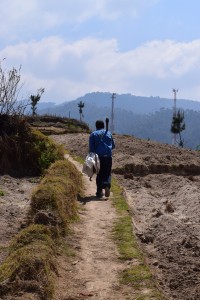 |
tired art. man The man is tired. |
 |
Je’l le tyox. pretty art. church The church is pretty. |
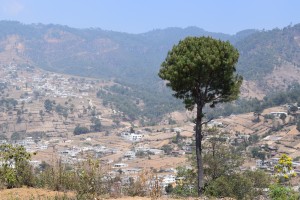 |
Nim raqan le che’. tall art. tree The tree is tall. |
 |
very big art. town The town is very big. |
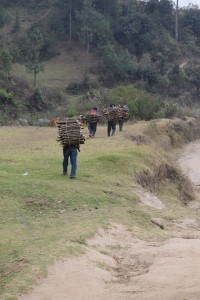 |
K’ax le ki-b’e le e winaq. hard art. their-road art. pl. people The people’s road is hard. |
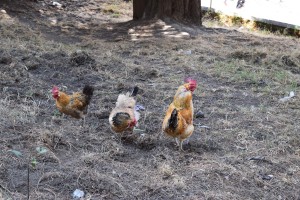 |
E k’o oxib’ ak’. pl. ex. three hens There are three hens. |
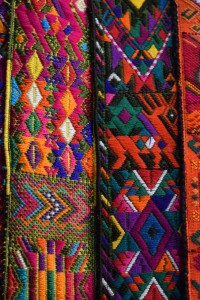 |
K’ak’ le po’t. new art. huipil The huipil is new. |
Phrases with k’o describe existing things in a place or location. Often a prepositional phrase (K’o oxib’ ixoqib’ pa k’ayib’al atz’yaq) (There are three women at the clothing store) is used.
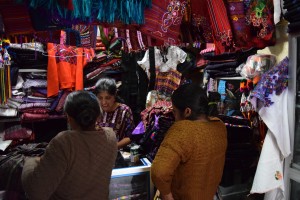 |
E k’o ixoqib’ pa le k’ayb’al. pl. ex. women prep. art. market There are women at the market. |
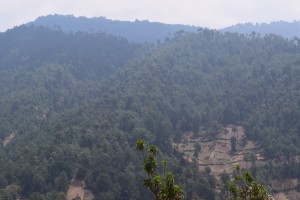 |
ex. tree prep. art. forest There are trees in the forest. |
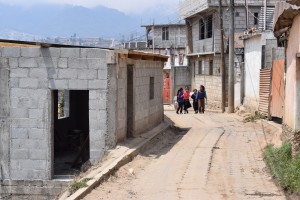 |
pl. ex. four children prep. art. road There are four children on the road. |
Here are a few more examples. Can you translate them into English?:
Rax le usu’t le nunan.
| ab’aj | rock, stone |
| ab’ix | cornfield, milpa |
| achi/achijab’ | man/men |
| ak’al/ak’alab’ | child/children |
| ala/alab’om | boy/boys |
| ali/altomab’ | girl/girls |
| amu’s | ladino, mestizo, a non-indigenous person |
| b’e | road |
| chak | work, job |
| chakub’al | working place, office |
| chaq’ | younger sibling of the same sex |
| chi’ | here, mouth |
| chikop | animal |
| chila’ | there |
| chom | fat |
| ixoq/ixoqib’ | woman/women |
| juyub’ | mountain, hill |
| k’a’n | mean, fierce |
| k’ajol | son (of man) |
| k’ak’ | new |
| -k’isb’al | the last one of |
| ko | hard |
| la’j | small |
| me’s | cat |
| nim | big |
| nim raqan | tall (literally: big his/her/its-leg) |
| nitz’ | small |
| pa | preposition (at, in, to, towards) |
| palaj | face |
| paqal | expensive, high, steep |
| pwaq | money, precious metals |
| q’eq | black |
| rajil | money |
| sib’alaj | very, much |
| wa | food |
Translate the following sentences.
- Nim le tijob’al
- Q’e’l le ratz’yaq le ak’al.
- Paqal rajil le nupo’t.
- K’o uxajab’ le ixoq.
- K’o nuchak pa tijob’al.
- K’o uchikopil le che’.
- Tat Wel k’o pa le ro’ch le nuchaq’.
- K’o upo’t le al We’l.
Answers
- The school is big.
- The boy’s clothes are old.
- My huipil (woven blouse) is expensive.
- The woman has shoes.
- I have my job at the school.
- The tree has animals.
- Mr. Manuel is at his younger brother’s house.
- Manuela has a huipil (woven blouse).
Form stative sentences from the following word pairs, then translate them into English.
Example: atz’yaq/q’e’l: Q’e’l le atz’yaq. The clothing/clothes are old.
- Tz’i’/nim
- Nupo’t/q’e’l
- Saq’ul/q’an
- Qachakub’al/nim
- Atz’ib’ab’al/kaq
- Chikop/nitz’
- Wuj/utz
- Ich’ich’/nim
- B’e/k’ak’
- Qawa/utz
Answers
- Nim le tz’i’. (The dog is big.)
- Q’e’l le nupo’t. (My huipil is old.)
- Q’an le saq’ul. (The banana is yellow.)
- Nim le qachakub’al. (Our office is big.)
- Kaq le azt’ib’ab’al. (The pencil is red.)
- Nitz’ le chikop. (The animal is small.)
- Utz le wuj. (The book is good.)
- Nim le ich’ich’. (Your car is big.)
- K’ak’ le b’e. (The road is good.)
- Utz le qawa. (Our food is good.)

